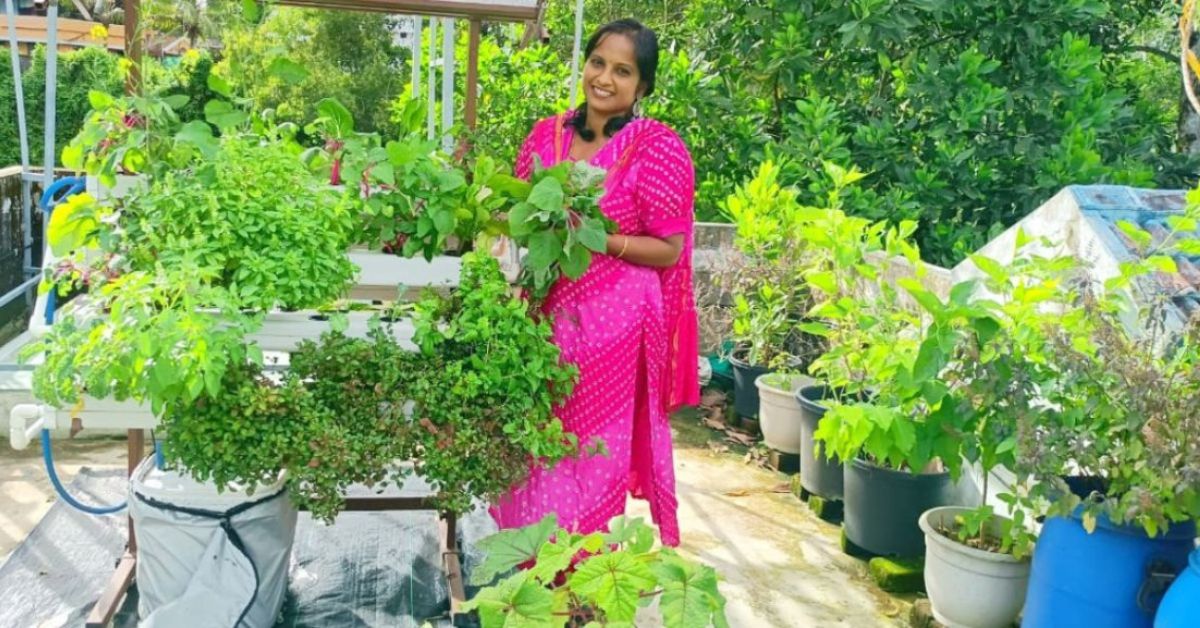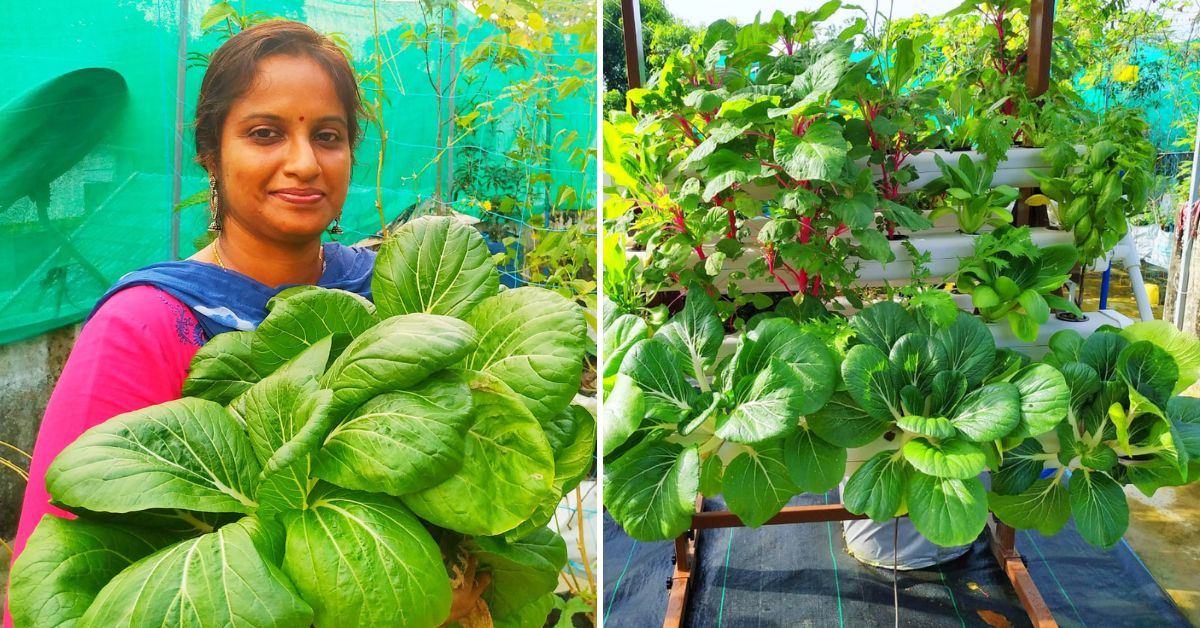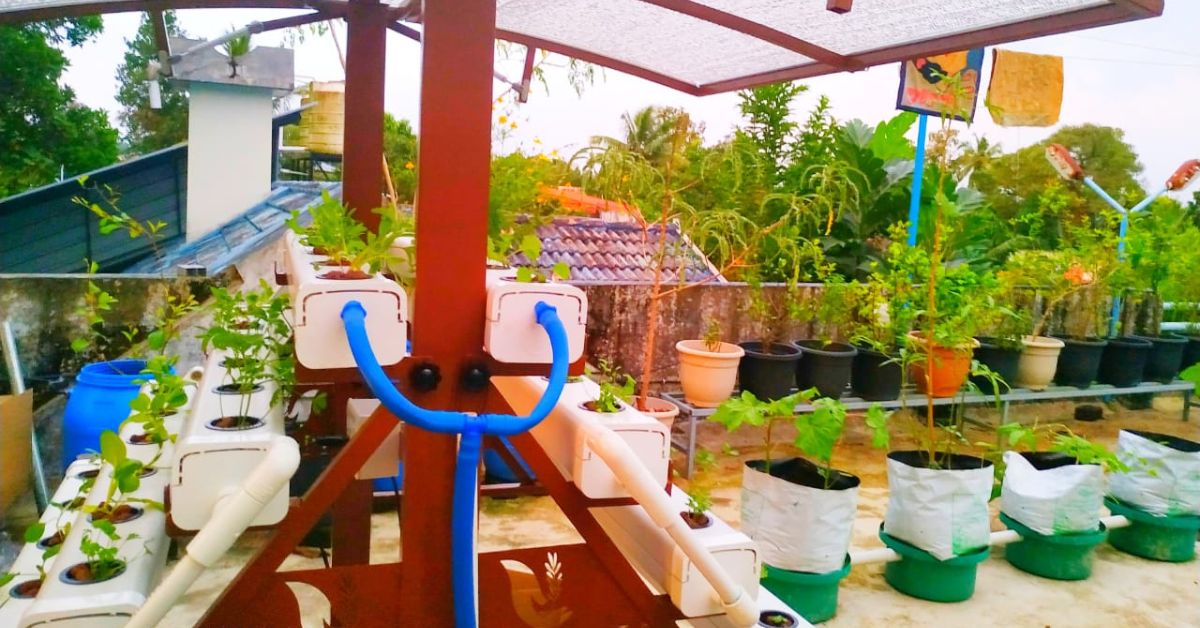How I Grow All Exotic Veggies From Bok Choy to Kale on My Terrace, Without Any Soil
Kerala resident Roopa Jos grows organic and exotic vegetables on her terrace using a hydroponics unit. She shares all about the cost of setting it up and how she grows veggies for her kitchen.

While growing up in Kolkata, Roopa Jos would visit her hometown in Kerala with her parents only during vacations. During those visits, she recalls that her father, who was a farming enthusiast, would collect vegetable seeds and saplings to take back home.
After marriage, when Roopa moved to Kerala, she decided to try her hands at farming. But this was more out of concern, she says.
“When I moved to Kerala, I expected that we would be able to eat fresh and clean vegetables. But within a few years, I realised that this wasn’t the case, as most of the vegetables available in the market were high on pesticides,” Roopa tells The Better India.
She started by setting up a small vegetable garden on her terrace. “When I started eating homegrown vegetables, I realised the huge difference in taste, freshness, and even health. Even the chillies I grew were tastier than those from the market,” she says, adding that this was the beginning of her agricultural journey.
Currently, Roopa has a full-fledged organic garden with fruits and vegetables on her 700 sq ft terrace and has not spared any spaces around her house, set on six cents of land. She has also set up a hydroponics unit on her terrace to grow fresh and exotic leafy vegetables. “Now we are self-sufficient, as we don’t buy any vegetables from the market,” she says.
Growing greens the hydroponic way

In 2014, when Roopa started her terrace farming venture, she never thought that it would turn out to be a serious passion. “Once I stepped into farming, I realised that it’s possible to grow any vegetables successfully if we take good care of them,” says Roopa, who is also a Kathak dancer and currently runs an art school at home.
She says she maintains her vegetable garden by using natural and organic manure.
Her garden now nurtures different varieties of vegetables, ranging from locally available ones like ladies finger, brinjal, tomatoes, cow pea, cucumber, etc, to exotic vegetables like kale, broccoli, bok choy, and so on.
“We love having leafy green vegetables at home, especially my husband and daughters, who prefer to have them as salads and snacks,” she says.
“I started with different varieties of spinach and realised that it wasn’t growing well due to the frequent rains and pest attacks. So, I looked for alternate ways. While searching on the internet, I discovered hydroponics, and learnt that it could be a better way to grow greens efficiently,” explains Roopa, adding that after learning about hydroponics, she bought a unit from ‘Plant Me’, an Aluva-based company specialising in hydroponics systems.
There are different types of hydroponics systems that can be installed according to one’s requirements and availability of space, she says. “We wanted a small system to be installed on our terrace to grow our greens without being affected by the rains. Thus after considering our requirements, we decided to go for a small unit that can be set up on the corner of the terrace. The unit is in the shape of an inverted V and has a UV shelter,” she elaborates.

The hydroponics unit Roopa installed has provision to plant 48 plants and cost her Rs 23,000. “It is like a stand where we can grow 24 plants on each side. The unit comes with a reservoir where the water is filled, and there is a submersive pump set through which the water is circulated everywhere,” says Roopa, who has been using the system for the past one year.
Apart from the cost of the unit, there are not many expenses except for the nutrient solution, which should be mixed in water from time to time after measuring the TDS (Total Dissolved Solids). “TDS is the measurement of how much nutrients and other concentrates are present in the water. There is a tool that comes along with the unit that can be used to measure it. The nutrient solution costs around Rs 500 and is easily available online,” she adds.
Roopa also grows Chinese cabbage, coriander, celery, parsley, palak, Italian basil, and more using hydroponics. “The greens are extra fresh and free of any kind of pests. We find them tastier than the ones grown on soil. But the best part about hydroponics is that we get a faster yield — within two to three weeks,” she says.
According to Roopa, while hydroponics is a soil-less mode of farming, it is important to keep a check on the unit at least once or twice a day. “We need to make sure that the pump is working without any fail, as continuous circulation of water is required for the plants. Also, make sure that there’s always enough water in the tank for circulation, as it might evaporate easily during summers. It is also essential to trim the roots of the veggies regularly, according to their growth, to avoid blockage leading to leakage,” she says.
Other than growing vegetables on her terrace, she also has an elaborate vegetable garden with a rain shelter on six cents of land opposite her house. “We take whatever is required for us and sell the rest of the yield to our friends and neighbours,” she says.
(Edited by Divya Sethu)
If you found our stories insightful, informative, or even just enjoyable, we invite you to consider making a voluntary payment to support the work we do at The Better India. Your contribution helps us continue producing quality content that educates, inspires, and drives positive change.
Choose one of the payment options below for your contribution-
By paying for the stories you value, you directly contribute to sustaining our efforts focused on making a difference in the world. Together, let’s ensure that impactful stories continue to be told and shared, enriching lives and communities alike.
Thank you for your support. Here are some frequently asked questions you might find helpful to know why you are contributing?


This story made me
-
97
-
121
-
89
-
167













